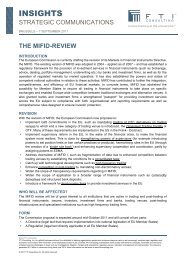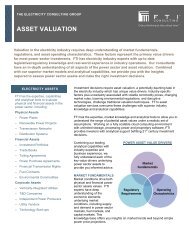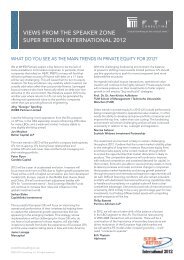Read White Paper - FTI Consulting
Read White Paper - FTI Consulting
Read White Paper - FTI Consulting
You also want an ePaper? Increase the reach of your titles
YUMPU automatically turns print PDFs into web optimized ePapers that Google loves.
works compatible and so they did.<br />
Since the cost of incompatibility is high, profits are lower for all competitors than they might be under compatibility.<br />
Consequently there often comes a point in the market leader’s progression when they have gained as<br />
much market share as possible under incompatibility and will shift to compatibility. In doing so, they pick up<br />
probably more than their fair share of the fence-sitting customers while lowering costs and improving profits.<br />
In addition, the leader can often create this compatibility by licensing access their dominant technology or<br />
network access to others, and thereby also gain new revenue from their competitors. This gives us an eighth<br />
principle:<br />
Principle 8: Since compatibility is more profitable, the market leader will usually shift to compatibility<br />
after capturing his market share under incompatibility.<br />
The Logic of Compliments<br />
When content is distributed on a many-to-many network, the network and the content shared on it are compliments.<br />
They are both required to deliver the service to the consumer, and the service cannot exist without<br />
both. While co-dependent, the network distributor and the content provider are rarely equal. A large distributor<br />
like Apple has significant pricing leverage over content owners, but with smaller distributors the content owner<br />
has pricing power.<br />
One important way to gain a price advantage when the players are complimentary is to commoditize your<br />
partners by finding several suppliers of the needed compliment. This is easy to see in the case of Yahoo<br />
News, who can commoditize its national news suppliers by making deals with Reuters, AP and even have its<br />
own journalists. This creates price competition among Yahoo’s news suppliers and weakens the suppliers’<br />
pricing leverage. Equally, content owners will seek many distribution partners so that no one of them has<br />
much power over the content owner. This gives us our ninth principle:<br />
Principle 9: Complimentary partners in a network will attempt to commoditize each other.<br />
A special case arises when there is only one source of content or only one significant distribution partner.<br />
Owners of unique content like a hit movie know its distribution partners can’t get it anywhere else and so they<br />
can’t be commoditized. This leads to their favorite axiom that content is king. But this is really only true when<br />
there are multiple distribution outlets. When there’s only one major distributor, content isn’t king. In the case of<br />
iTunes, who owns 90% of the digital music download market, iTunes has set a uniform and low price for all<br />
songs of 99 cents. They have virtually commoditized the music labels’ content. Consequently when content<br />
owners with desirable content come up against a dominant distributor, things can get fractious.<br />
This leads to our last principle:<br />
Principle 10: Complimentary networks exist only when the participants’ revenue models are aligned.<br />
This is not quite as obvious as it sounds. Of course, the participants in a delivery network won’t do business<br />
with each other if they can’t make money, but it’s how they each make their money that makes the partnership<br />
possible. For example, MTV distributes its content nationally through various cable companies. The two parties<br />
have found alignment: the cable companies make money through subscription fees to the consumer, while<br />
MTV makes money through advertising within the content. (MTV also get some licensing fees from the cable<br />
operator.) This is not the case with YouTube. Both the content owners and YouTube’s parent, Google, want<br />
to make money from advertising in the content. To date, they can’t agree on a revenue sharing arrangement<br />
or who owns the customer relationship. Their business models are out of alignment.<br />
<strong>FTI</strong> CONSULTING | ADVANCED AD OPTIMIZATION RAISES REVENUE AND REDUCES COSTS IN TELEVISION AND RADIO 8
















